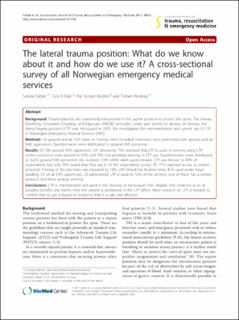| dc.contributor.author | Fattah, Sabina | |
| dc.contributor.author | Ekås, Guri Ranum | |
| dc.contributor.author | Hyldmo, Per Kristian | |
| dc.contributor.author | Wisborg, Torben | |
| dc.coverage.spatial | Norway | en_US |
| dc.date.accessioned | 2022-05-31T12:55:04Z | |
| dc.date.available | 2022-05-31T12:55:04Z | |
| dc.date.created | 2011-10-28T12:44:05Z | |
| dc.date.issued | 2011 | |
| dc.identifier.citation | Scandinavian Journal of Trauma, Resuscitation and Emergency Medicine. 2011, 19 . | en_US |
| dc.identifier.issn | 1757-7241 | |
| dc.identifier.uri | https://hdl.handle.net/11250/2997071 | |
| dc.description.abstract | Background: Trauma patients are customarily transported in the supine position to protect the spine. The Airway, Breathing, Circulation, Disability, and Exposure (ABCDE) principles clearly give priority to airways. In Norway, the lateral trauma position (LTP) was introduced in 2005. We investigated the implementation and current use of LTP in Norwegian Emergency Medical Services (EMS).
Methods: All ground and air EMS bases in Norway were included. Interviews were performed with ground and air EMS supervisors. Questionnaires were distributed to ground EMS personnel.
Results: Of 206 ground EMS supervisors, 201 answered; 75% reported that LTP is used. In services using LTP, written protocols were present in 67% and 73% had provided training in LTP use. Questionnaires were distributed to 3,025 ground EMS personnel. We received 1,395 (46%) valid questionnaires. LTP was known to 89% of respondents, but only 59% stated that they use it. Of the respondents using LTP, 77% reported access to written protocols. Flexing of the top knee was reported by 78%, 20% flexed the bottom knee, 81% used under head padding. Of 24 air EMS supervisors, 23 participated. LTP is used by 52% of the services, one of these has a written protocol and three arrange training.
Conclusions: LTP is implemented and used in the majority of Norwegian EMS, despite little evidence as to its possible benefits and harms. How the patient is positioned in the LTP differs. More research on LTP is needed to confirm that its use is based on evidence that it is safe and effective. | en_US |
| dc.language.iso | eng | en_US |
| dc.publisher | BioMed Central | en_US |
| dc.rights | Attribution-NonCommercial-NoDerivatives 4.0 Internasjonal | * |
| dc.rights.uri | http://creativecommons.org/licenses/by-nc-nd/4.0/deed.no | * |
| dc.subject | Emergency Medical Services; | en_US |
| dc.subject | Emergency Medical Technicians; | en_US |
| dc.subject | Humans; | en_US |
| dc.subject | Norway; | en_US |
| dc.subject | Surveys and Questionnaires; | en_US |
| dc.subject | Transportation of Patients / methods*; | en_US |
| dc.subject | Cross-Sectional Studies; | en_US |
| dc.subject | Trauma; | en_US |
| dc.subject | Posture; | en_US |
| dc.title | The lateral trauma position: What do we know about it and how do we use it? A cross-sectional survey of all Norwegian emergency medical services | en_US |
| dc.title.alternative | The lateral trauma position: What do we know about it and how do we use it? A cross-sectional survey of all Norwegian emergency medical services | en_US |
| dc.type | Peer reviewed | en_US |
| dc.type | Journal article | en_US |
| dc.description.version | publishedVersion | en_US |
| dc.rights.holder | © 2011 Fattah et al; licensee BioMed Central Ltd. This is an Open Access article distributed under the terms of the Creative Commons Attribution License (http://creativecommons.org/licenses/by/2.0), which permits unrestricted use, distribution, and reproduction in any medium, provided the original work is properly cited. | en_US |
| dc.source.pagenumber | 5 | en_US |
| dc.source.volume | 19 | en_US |
| dc.source.journal | Scandinavian Journal of Trauma, Resuscitation and Emergency Medicine | en_US |
| dc.identifier.doi | 10.1186/1757-7241-19-45 | |
| dc.identifier.cristin | 848724 | |
| cristin.ispublished | true | |
| cristin.fulltext | original | |
| cristin.qualitycode | 1 | |

